Animal migration
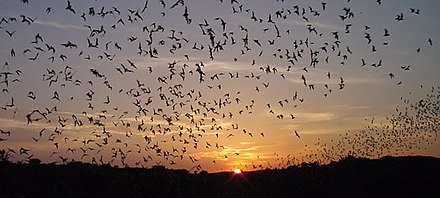
Animal migrationis the relatively long-distance movement of individualanimals,usually on aseasonalbasis. It is the most common form ofmigrationin ecology. It is found in all major animal groups, includingbirds,mammals,fish,reptiles,amphibians,insects,andcrustaceans.The cause of migration may be local climate, local availability of food, the season of the year or for mating.
To be counted as a true migration, and not just a localdispersalor irruption, the movement of the animals should be an annual or seasonal occurrence, or a major habitat change as part of their life. An annual event could includeNorthern Hemispherebirds migrating south for the winter, orwildebeestmigrating annually for seasonal grazing. A major habitat change could include youngAtlantic salmonor sea lamprey leaving the river of their birth when they have reached a few inches in size. Some traditional forms ofhuman migrationfit this pattern.
Migrations can be studied using traditional identification tags such asbird rings,or tracked directly with electronic tracking devices. Before animal migration was understood, folklore explanations were formulated for the appearance and disappearance of some species, such as thatbarnacle geesegrew fromgoose barnacles.
Overview
[edit]Concepts
[edit]
Migration can take very different forms in different species, and has a variety of causes.[1][2][3] As such, there is no simple accepted definition of migration.[4]One of the most commonly used definitions, proposed by the zoologist J. S. Kennedy[5]is
Migratory behavior is persistent and straightened-out movement effected by the animal's own locomotory exertions or by its active embarkation on a vehicle. It depends on some temporary inhibition of station-keeping responses, but promotes their eventual disinhibition and recurrence.[5]
Migration encompasses four related concepts: persistent straight movement; relocation of an individual on a greater scale (in both space and time) than its normal daily activities; seasonal to-and-fro movement of a population between two areas; and movement leading to the redistribution of individuals within a population.[4]Migration can be eitherobligate,meaning individuals must migrate, or facultative, meaning individuals can "choose" to migrate or not. Within a migratory species or even within a single population, often not all individuals migrate.Complete migrationis when all individuals migrate,partial migrationis when some individuals migrate while others do not, anddifferential migrationis when the difference between migratory and non-migratory individuals is based on discernible characteristics like age or sex.[4]Irregular (non-cyclical) migrations such as irruptions can occur under pressure of famine,overpopulationof a locality, or some more obscure influence.[6]
Seasonal
[edit]Seasonal migration is the movement of various species from one habitat to another during the year. Resource availability changes depending on seasonal fluctuations, which influence migration patterns. Some species such as Pacific salmon migrate to reproduce; every year, they swim upstream to mate and then return to the ocean.[7]Temperature is a driving factor of migration that is dependent on the time of year. Many species, especially birds, migrate to warmer locations during the winter to escape poor environmental conditions.[8]
Circadian
[edit]Circadian migration is where birds utilisecircadian rhythm(CR) to regulate migration in both fall and spring. In circadian migration, clocks of both circadian (daily) and circannual (annual) patterns are used to determine the birds' orientation in both time and space as they migrate from one destination to the next. This type of migration is advantageous in birds that, during the winter, remain close to the equator, and also allows the monitoring of the auditory and spatial memory of the bird's brain to remember an optimal site of migration. These birds also have timing mechanisms that provide them with the distance to their destination.[9]
Tidal
[edit]Tidal migration is the use of tides by organisms to move periodically from one habitat to another. This type of migration is often used in order to find food or mates. Tides can carry organisms horizontally and vertically for as little as a few nanometres to even thousands of kilometres.[10]The most common form of tidal migration is to and from theintertidal zoneduring daily tidal cycles.[10]These zones are often populated by many different species and are rich in nutrients. Organisms like crabs, nematodes, and small fish move in and out of these areas as the tides rise and fall, typically about every twelve hours. The cycle movements are associated with foraging of marine and bird species. Typically, during low tide, smaller or younger species will emerge to forage because they can survive in the shallower water and have less chance of being preyed upon. During high tide, larger species can be found due to the deeper water and nutrient upwelling from the tidal movements. Tidal migration is often facilitated byocean currents.[11][12][13]
Diel
[edit]While most migratory movements occur on an annual cycle, some daily movements are also described as migration. Many aquatic animals make adiel vertical migration,travelling a few hundred metres up and down the water column,[14]while some jellyfish make daily horizontal migrations of a few hundred metres.[15]
In specific groups
[edit]Different kinds of animals migrate in different ways.
In birds
[edit]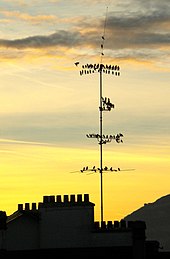
Approximately 1,800 of the world's 10,000bird species migrate long distanceseach year in response to the seasons.[16]Many of these migrations are north-south, with species feeding and breeding in high northern latitudes in the summer and moving some hundreds of kilometres south for the winter.[17]Some species extend this strategy to migrate annually between the Northern and Southern Hemispheres. TheArctic ternhas the longest migration journey of any bird: it flies from itsArcticbreeding grounds to theAntarcticand back again each year, a distance of at least 19,000 km (12,000 mi), giving it two summers every year.[18]
Bird migration is controlled primarily by day length, signalled by hormonal changes in the bird's body.[19]On migration, birdsnavigateusing multiple senses. Many birds use a sun compass, requiring them to compensate for the sun's changing position with time of day.[20]Navigation involves the ability todetect magnetic fields.[21]
In fish
[edit]
Most fish species are relatively limited in their movements, remaining in a single geographical area and making short migrations to overwinter, tospawn,or to feed. A few hundred species migrate long distances, in some cases of thousands of kilometres. About 120 species of fish, including several species ofsalmon,migrate between saltwater and freshwater (they are 'diadromous').[22][23]
Forage fishsuch asherringandcapelinmigrate around substantial parts of the NorthAtlanticocean. The capelin, for example, spawn around the southern and western coasts of Iceland; their larvae drift clockwise around Iceland, while the fish swim northwards towardsJan Mayenisland to feed and return to Iceland parallel with Greenland's east coast.[24]
In the 'sardine run', billions of Southern AfricanpilchardSardinops sagaxspawn in the cold waters of theAgulhas Bankand move northward along the east coast ofSouth Africabetween May and July.[25]
In insects
[edit]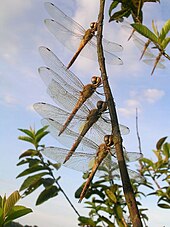
Some wingedinsectssuch aslocustsand certainbutterfliesanddragonflieswith strong flight migrate long distances. Among the dragonflies, species ofLibellulaandSympetrumare known for mass migration, whilePantala flavescens,known as the globe skimmer or wandering glider dragonfly, makes the longest ocean crossing of any insect: between India and Africa.[26]Exceptionally, swarms of the desert locust,Schistocerca gregaria,flew westwards across the Atlantic Ocean for 4,500 kilometres (2,800 mi) during October 1988, using air currents in theInter-Tropical Convergence Zone.[27]
In somemigratory butterflies,such as themonarch butterflyand thepainted lady,no individual completes the whole migration. Instead, the butterflies mate and reproduce on the journey, and successive generations continue the migration.[28]
In mammals
[edit]Some mammals undertake exceptional migrations;reindeerhave one of the longest terrestrial migrations on the planet, reaching as much as 4,868 kilometres (3,025 mi) per year in North America. However, over the course of a year,grey wolvesmove the most. One grey wolf covered a total cumulative annual distance of 7,247 kilometres (4,503 mi).[29]

Mass migration occurs in mammals such as theSerengeti 'great migration',an annual circular pattern of movement with some 1.7 millionwildebeestand hundreds of thousands of other large game animals, includinggazellesandzebra.[30][31]More than 20 such species engage, or used to engage, in mass migrations.[32]Of these migrations, those of thespringbok,black wildebeest,blesbok,scimitar-horned oryx,andkulanhave ceased.[33]Long-distance migrations occur in some bats – notably the mass migration of theMexican free-tailed batbetween Oregon and southern Mexico.[34]Migration is important incetaceans,including whales, dolphins and porpoises; some species travel long distances between their feeding and their breeding areas.[35]
Humans are mammals, buthuman migration,as commonly defined, is when individuals often permanently change where they live, which does not fit the patterns described here. An exception is some traditional migratory patterns such astranshumance,in which herders and their animals move seasonally between mountains and valleys, and the seasonal movements ofnomads.[36][37]
In other animals
[edit]Among the reptiles, adultsea turtles migratelong distances to breed, as do some amphibians. Hatchling sea turtles, too, emerge from underground nests, crawl down to the water, and swim offshore to reach the open sea.[38]Juvenilegreen sea turtlesmake use ofEarth's magnetic fieldto navigate.[39]
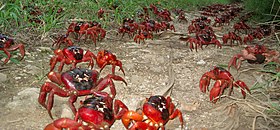
Some crustaceans migrate, such as the largely-terrestrialChristmas Island red crab,which moves en masse each year by the millions. Like other crabs, they breathe using gills, which must remain wet, so they avoid direct sunlight, digging burrows to shelter from the sun. They mate on land near their burrows. The females incubate their eggs in their abdominal brood pouches for two weeks. Then they return to the sea to release their eggs at high tide in the moon's last quarter. The larvae spend a few weeks at sea and then return to land.[40][41]
Tracking migration
[edit]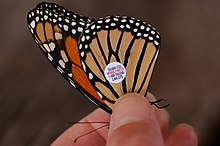
Scientists gather observations of animal migration by tracking their movements. Animals were traditionally tracked with identification tags such asbird ringsfor later recovery. However, no information was obtained about the actual route followed between release and recovery, and only a fraction of tagged individuals were recovered. More convenient, therefore, are electronic devices such asradio-tracking collarsthat can be followed by radio, whether handheld, in a vehicle or aircraft, or by satellite.[42]GPS animal trackingenables accurate positions to be broadcast at regular intervals, but the devices are inevitably heavier and more expensive than those without GPS. An alternative is the Argos Doppler tag, also called a 'Platform Transmitter Terminal' (PTT), which sends regularly to the polar-orbiting Argos satellites; usingDoppler shift,the animal's location can be estimated, relatively roughly compared to GPS, but at a lower cost and weight.[42]A technology suitable for small birds which cannot carry the heavier devices is thegeolocatorwhichlogs the light levelas the bird flies, for analysis on recapture.[43]There is scope for further development of systems able to track small animals globally.[44]
Radio-tracking tags can be fitted to insects, includingdragonfliesandbees.[45]
In culture
[edit]Before animal migration was understood, various folklore and erroneous explanations were formulated to account for the disappearance or sudden arrival of birds in an area. InAncient Greece,Aristotleproposed that robins turned intoredstartswhen summer arrived.[46]Thebarnacle goosewas explained in European Medieval bestiaries and manuscripts as either growing like fruit on trees, or developing fromgoose barnacleson pieces of driftwood.[47]Another example is theswallow,which was once thought, even bynaturalistssuch asGilbert White,tohibernateeither underwater, buried in muddy riverbanks, or in hollow trees.[48]
See also
[edit]References
[edit]- ^Attenborough, David(1990).The Trials of Life.London: Collins/BBCBooks. p. 123.ISBN978-0-00-219940-7.
- ^Silva, S.; Servia, M. J.; Vieira-Lanero, R.; Cobo, F. (2012). "Downstream migration and hematophagous feeding of newly metamorphosed sea lampreys (Petromyzon marinus Linnaeus, 1758)".Hydrobiologia.700(1): 277–286.doi:10.1007/s10750-012-1237-3.ISSN0018-8158.S2CID16752713.
- ^National Geographic. Why Animals MigrateArchived28 July 2011 at theWayback Machine
- ^abcDingle, Hugh; Drake, V. Alistair (2007). "What is migration?".BioScience.57(2): 113–121.doi:10.1641/B570206.S2CID196608896.
- ^abKennedy, J. S. (1985). "Migration: Behavioral and ecological". In Rankin, M. (ed.).Migration: Mechanisms and Adaptive Significance: Contributions in Marine Science.Marine Science Institute. pp. 5–26.
- ^Ingersoll, Ernest(1920)..In Rines, George Edwin (ed.).Encyclopedia Americana.
- ^"About Pacific Salmon".Pacific Salmon Commission.12 February 2015.Retrieved30 April2020.
- ^"The Basics of Bird Migration: How, Why, and Where".All About Birds.1 January 2007.Retrieved30 April2020.
- ^Gwinner, E (1996). "Circadian and circannual programmes in avian migration".Journal of Experimental Biology.199(Pt 1): 39–48.doi:10.1242/jeb.199.1.39.ISSN0022-0949.PMID9317295.
- ^abGibson, R. (2003). "Go with the flow: tidal migration in marine animals".Hydrobiologia.503(1–3): 153–161.doi:10.1023/B:HYDR.0000008488.33614.62.S2CID11320839.
- ^Hufnagl, M.; Temming, A.; Pohlmann, T. (2014). "The missing link: tidal-influenced activity a likely candidate to close the migration triangle in brown shrimpCrangon crangon(Crustacea, Decapoda) ".Fisheries Oceanography.23(3): 242–257.Bibcode:2014FisOc..23..242H.doi:10.1111/fog.12059.
- ^Brenner, M.; Krumme, U. (2007)."Tidal migration and patterns in feeding of the four-eyed fishAnableps anablepsL. in a north Brazilian mangrove "(PDF).Journal of Fish Biology.70(2): 406–427.Bibcode:2007JFBio..70..406B.doi:10.1111/j.1095-8649.2007.01313.x.
{{cite journal}}:CS1 maint: multiple names: authors list (link) - ^Gibson, R. N. (2003). "Go with the Flow: Tidal Migration in Marine Animals".Hydrobiologia.503(1–3): 153–161.CiteSeerX10.1.1.463.6977.doi:10.1023/B:HYDR.0000008488.33614.62.S2CID11320839.
- ^McLaren, I. A. (1974). "Demographic strategy of vertical migration by a marine copepod".The American Naturalist.108(959): 91–102.doi:10.1086/282887.JSTOR2459738.S2CID83760473.
- ^Hamner, W. M.; Hauri, I. R. (1981). "Long-distance horizontal migrations of zooplankton (Scyphomedusae: Mastigias)".Limnology and Oceanography.26(3): 414–423.Bibcode:1981LimOc..26..414I.doi:10.4319/lo.1981.26.3.0414.
- ^Sekercioglu, C. H. (2007)."Conservation ecology: area trumps mobility in fragment bird extinctions".Current Biology.17(8): 283–286.Bibcode:2007CBio...17.R283S.doi:10.1016/j.cub.2007.02.019.PMID17437705.S2CID744140.
- ^Berthold, Peter; Bauer, Hans-Günther; Westhead, Valerie (2001).Bird Migration: A General Survey.Oxford: Oxford University Press.ISBN978-0-19-850787-1.
- ^Cramp, Steve, ed. (1985).Birds of the Western Palearctic.pp. 87–100.ISBN978-0-19-857507-8.
- ^Fusani, L.; Cardinale, L.; Carere, C.; Goymann, W. (2009)."Stopover decision during migration: physiological conditions predict nocturnal restlessness in wild passerines".Biology Letters.5(3): 302–305.doi:10.1098/rsbl.2008.0755.PMC2679912.PMID19324648.
- ^Lockley, Ronald M.(1967).Animal Navigation.Pan Books. p. 136.
- ^Heyers, D.; Manns, M. (2007). Iwaniuk, Andrew (ed.)."A Visual Pathway Links Brain Structures Active during Magnetic Compass Orientation in Migratory Birds".PLOS ONE.2(9). Luksch, H; Güntürkün, O; Mouritsen, H.: e937.Bibcode:2007PLoSO...2..937H.doi:10.1371/journal.pone.0000937.PMC1976598.PMID17895978.
- ^Harden Jones, F. R.Fish Migration: strategy and tactics.pp139–166 in Aidley, 1981.
- ^Myers, George S. (1949). "Usage of Anadromous, Catadromous and allied terms for migratory fishes".Copeia.1949(2): 89–97.doi:10.2307/1438482.JSTOR1438482.
- ^Barbaro, A.; Einarsson, B.; Birnir, B.; Sigurðsson, S.; Valdimarsson, S.; Pálsson, Ó.K.; Sveinbjörnsson, S.; Sigurðsson, P. (2009)."Modelling and simulations of the migration of pelagic fish"(PDF).Journal of Marine Science.66(5): 826–838.doi:10.1093/icesjms/fsp067.
- ^Fréon, P.; Coetzee, J. C.; Van Der Lingen, C. D.; Connell, A. D.; o'Donoghue, S. H.; Roberts, M. J.; Demarcq, H.; Attwood, C.G.; Lamberth, S. J. (2010)."A review and tests of hypotheses about causes of the KwaZulu-Natal sardine run".African Journal of Marine Science.32(2): 449–479.Bibcode:2010AfJMS..32..449F.doi:10.2989/1814232X.2010.519451.S2CID84513261.Archived fromthe originalon 20 April 2012.
- ^Williams, C. B. (1957). "Insect Migration".Annual Review of Entomology.2(1): 163–180.doi:10.1146/annurev.en.02.010157.001115.
- ^Tipping, Christopher (8 May 1995)."Chapter 11: The Longest Migration".Book of Insect Records.Department of Entomology & Nematology University of Florida.Archivedfrom the original on 24 September 2015.
- ^Stefanescu, Constantí; Páramo, Ferran; Åkesson, Susanne; Alarcón, Marta; Ávila, Anna; Brereton, Tom; Carnicer, Jofre; Cassar, Louis F.; Fox, Richard; Heliölä, Janne; Hill, Jane K.; Hirneisen, Norbert; Kjellén, Nils; Kühn, Elisabeth; Kuussaari, Mikko; Leskinen, Matti; Liechti, Felix; Musche, Martin; Regan, Eugenie C.; Reynolds, Don R.; Roy, David B.; Ryrholm, Nils; Schmaljohann, Heiko; Settele, Josef; Thomas, Chris D.; van Swaay, Chris; Chapman, Jason W. (2013)."Multi-generational long-distance migration of insects: studying the painted lady butterfly in the Western Palaearctic"(PDF).Ecography.36(4): 474–486.doi:10.1111/j.1600-0587.2012.07738.x.ISSN0906-7590.
- ^Joly, Kyle; Gurarie, Eliezer; Sorum, Mathew S.; Kaczensky, Petra; Cameron, Matthew D.; Jakes, Andrew F.; Borg, Bridget L.; Nandintsetseg, Dejid; Hopcraft, J. Grant C.; Buuveibaatar, Bayarbaatar; Jones, Paul F. (December 2019)."Longest terrestrial migrations and movements around the world".Scientific Reports.9(1): 15333.Bibcode:2019NatSR...915333J.doi:10.1038/s41598-019-51884-5.ISSN2045-2322.PMC6814704.PMID31654045.
- ^"How to Get There, Ngorongoro Crater".Ngorongoro Crater Tanzania. 2013.Archivedfrom the original on 22 March 2014.Retrieved19 June2014.
- ^"Ngorongoro Conservation Area".United Nations Educational, Scientific and Cultural Organization– World Heritage Centre.Archivedfrom the original on 12 June 2014.Retrieved19 June2014.
- ^Harris, Grant; et al. (Apr 2009)."Global decline in aggregated migrations of large terrestrial mammals"(PDF).Endangered Species Research.7:55–76.doi:10.3354/esr00173.
- ^van Oosterzee, Penny (9 December 2017)."Wildebeest no more: The death of Africa's great migrations".New Scientist.Cites Harris et al. Seefigure.
- ^"Bats & Migration".Organization for Bat Conservation. Archived fromthe originalon 14 June 2014.Retrieved19 June2014.
- ^Lockyer, C. H. and Brown, S. G.The Migration of Whales.pp. 105–137 inAidley 1981.
- ^Baldridge, Elizabeth (27 August 2020)."Migration vs. Immigration: Understanding the Nuances".The Word Point.Retrieved1 October2021.
- ^Quinlan, T.; Morris, C. D. (1994). "Implications of changes to the transhumance system for conservation of the mountain catchments in eastern Lesotho".African Journal of Range & Forage Science.11(3): 76–81.Bibcode:1994AJRFS..11...76Q.doi:10.1080/10220119.1994.9647851.ISSN1022-0119.
- ^Russell, A. P.; Bauer, A. M.; Johnson, M. K. (2005). Ashraf, M. T. (ed.).Migration of Organisms.Springer. pp. 151–203.doi:10.1007/3-540-26604-6_7.ISBN978-3-540-26603-7.
- ^Lohmann, Kenneth J.; Lohmann, Catherine M. F.; Ehrhart, Llewellyn M.; Bagley, Dean A.; Swing, Timothy (2004). "Geomagnetic map used in sea-turtle navigation".Nature.428(6986): 909–910.doi:10.1038/428909a.PMID15118716.S2CID4329507.
- ^"Red Crabs".Parks Australia. 2013.Archivedfrom the original on 3 July 2014.Retrieved19 June2014.
- ^Adamczewska, Agnieszka M.; Morris, Stephen (June 2001)."Ecology and behaviour ofGecarcoidea natalis,the Christmas Island red crab, during the annual breeding migration ".The Biological Bulletin.200(3): 305–320.doi:10.2307/1543512.JSTOR1543512.PMID11441973.S2CID28150487.
- ^ab"What is animal tracking?".Movebank: For Animal Tracking Data.Archivedfrom the original on 21 April 2014.
- ^Stutchbury, Bridget J. M.; Tarof, Scott A.; Done, Tyler; Gow, Elizabeth; Kramer, Patrick M.; Tautin, John; Fox, James W.; Afanasyev, Vsevolod (2009-02-13). "Tracking Long-Distance Songbird Migration by Using Geolocators".Science.323(5916): 896.Bibcode:2009Sci...323..896S.doi:10.1126/science.1166664.ISSN0036-8075.PMID19213909.S2CID34444695.
- ^Wikelski, Martin; Kays, Roland W.; Kasdin, N. Jeremy; Thorup, Kasper; Smith, James A.; Swenson, George W. (15 January 2007). "Going wild: what a global small-animal tracking system could do for experimental biologists".Journal of Experimental Biology.210(2). The Company of Biologists: 181–186.doi:10.1242/jeb.02629.ISSN1477-9145.PMID17210955.S2CID8073226.
- ^"Tracking Migration of Dragonflies, Sparrows, and Bees".National Geographic.Archived fromthe originalon 30 May 2014.
- ^"The Earthlife Web – What is Bird Migration".Archivedfrom the original on 25 September 2009.
- ^"Medieval Bestiary – Barnacle Goose".Archivedfrom the original on 25 November 2016.
- ^Cocker, Mark;Mabey, Richard(2005).Birds Britannica.Chatto & Windus.p. 315.ISBN978-0-7011-6907-7.
Further reading
[edit]General
[edit]- Aidley, D. J. (1981).Animal migration.Cambridge University Press.ISBN978-0-52123-274-6.
- Baker, R. R. (1978)The Evolutionary Ecology of Animal Migration.Holmes & Meier.ISBN978-0-34019-409-6.
- Dingle, H. (1996)Migration: The Biology of Life on the Move.Oxford University Press.ISBN978-0-19802-577-1.
- Gauthreaux, S. A. (1980)Animal Migration, Orientation, and Navigation.Academic Press.ISBN978-0-12277-750-9.
- Milner-Gulland, E. J., Fryxell, J. M., and Sinclair, A. R. E. (2011)Animal Migration: A Synthesis.Oxford University Press.ISBN978-0-19956-899-4.
- Rankin, M. (1985)Migration: Mechanisms and Adaptive Significance: Contributions in Marine Science.Marine Science Institute.OCLC747358527.
- Riede, K. (2002)Global Register of Migratory Species. With database and GIS maps on CD.ISBN978-3-78433-826-2.
By group
[edit]- Drake, V. A. and Gatehouse, A. G. (1995)Insect migration: tracking resources through space and time.Cambridge University Press.ISBN978-0-52101-853-1
- Elphick, J. (1995)The atlas of bird migration: tracing the great journeys of the world's birds.Random House.ISBN978-1-55407-971-1
- Greenberg, R. and Marra, P. P. (2005)Birds of Two Worlds: The Ecology and Evolution of Migration.Johns Hopkins University Press.ISBN978-0-80188-107-7
- Lucas, M. C. and Baras, E. (2001)Migration of freshwater fishes.Blackwell Science.ISBN978-0-47099-964-6
- MacKeown, B. A. (1984)Fish migration.Timber Press.ISBN978-0-91730-499-6
- Sonnenschein, E; Berthold, P. (2003)Avian migration.Springer.ISBN978-3-54043-408-5
For children
[edit]- Gans, R. and Mirocha, P.How do Birds Find their Way?HarperCollins.(Stage 2)ISBN978-0-43969-940-2
- Marsh, L. (2010)Amazing Animal Journeys.National Geographic Society.(Level 3)ISBN978-0-00826-686-8
External links
[edit]- Migration Basics from U.S. National Park Service
- Witnessing the Great Migration in Serengeti and Masai Mara
- Global Register of Migratory Species– identifies, maps and features 4,300 migratory vertebrate species
- Animal migration on PubMedMeSHtermF01.145.113.083

